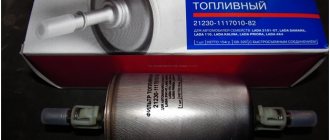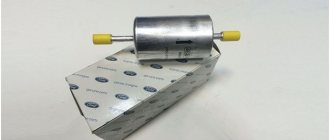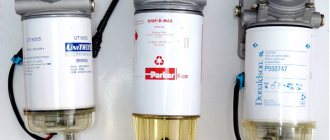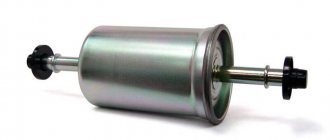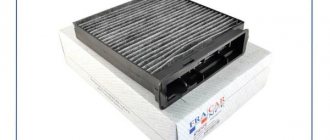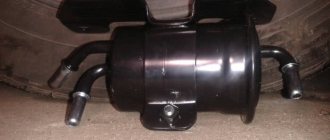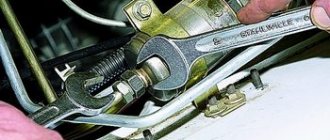The property of diesel fuel to solidify at subzero temperatures poses the challenge of ensuring an uninterrupted supply of diesel fuel during a cold start. An effective solution for normal pumping of fuel through the fuel system is heating of individual structural elements that are included in the diesel engine fuel line circuit. These include: fuel intakes, pre-cleaning separator filters and fine filters, as well as pipelines.
The market offers ready-made solutions that can be heated and are installed to replace standard elements. The main disadvantage of such devices is their high cost. For this reason, many car enthusiasts prefer to implement heating of diesel fuel with their own hands.
We also recommend reading the article on how to clean the diesel particulate filter. From this article you will learn about the basic ways to clean this filter yourself.
Fuel intake heating
Diesel fuel freezes already in the fuel tank. For this reason, preheating it when there is a big minus outside the window allows you to restore the fluidity of diesel fuel. You can raise the temperature in the fuel tank in different ways. One of the simplest is the solution to lower a regular 50-watt light bulb into the tank, which is located near the fuel intake. During operation, the light bulb heats up, the paraffin dissolves, and the system is able to pump diesel fuel.
The second way is to independently build an electric heating of diesel fuel with your own hands. Such heating will be similar in principle to a heating coil. To solve the problem you will need to get to the fuel intake grid. Then small diameter holes are drilled in the body at an equal distance from each other. It is recommended to make about 5 such holes on each side.
Please note that independent implementation of this electric heater circuit must be carried out taking into account the fact that the design must necessarily have a fuse. You will also need to equip the circuit with a special button to turn on the heating. An additional element is a relay for automatically turning off the current supply.
Next, you will need a wire whose material has high resistance. Tin wire works well for this task. The specified wire must be threaded through the prepared holes in the housing, creating a heater. The free ends will need to be connected to the power supply when finished.
Benefits of using the device
By using a heated filter on a car, you can significantly increase the service life of the engine.
There is also no need to purchase various starting additives, the battery saves its resource. Starting the engine in a cold period contributes to excessive wear of its parts, and in the case of easy starting and rapid warming up, the wear factor is significantly reduced. This also eliminates frequent repairs of the fuel system and its connecting elements.
Heating of the coarse filter
The filter heating circuit can be implemented and diesel fuel fluidity can be ensured by the following modifications: the drain valve is replaced with a glow plug or the heating element is mounted in the body of the fitting through which fuel is supplied. In the process of implementing these schemes, you will need special equipment in the form of a lathe or contact specialists who can produce handicraft parts.
Please note that removing the drain valve will not allow you to subsequently remove excess water from the fuel supply system that may be present in the diesel fuel. You should resort to this heating method only if you are completely confident in the quality of the diesel fuel being filled.
To carry out the work, the coarse filter (separator) is removed. After this, you need to machine a sleeve from steel, which will act as a substitute for the drain cap. Next, a thread is cut to securely attach the element to the filter housing. After this, a hole is drilled in the bushing and an internal thread is cut with a tap, through which the stud will be attached.
Then the glow plug is screwed in, the positive wire is fed to the heating element, the negative wire is fed to the stud. The finished solution is screwed into the separator body. All work related to the implementation of the electrical circuit implies the same requirements that were put forward when creating heating of the fuel intake from the on-board network of a diesel vehicle.
We also recommend reading the article on how to increase the power of a diesel engine. From this article you will learn about how you can increase the efficiency of the engine by installing a special tuning box and the main advantages compared to chip tuning.
There is also a simplified method for installing a glow plug, which does not require recessing individual additional elements. To install a glow plug in the valve fitting, you need to drill a hole, cut a thread in it and screw in the glow plug. The power supply is connected in the same way. It should be added that the second scheme is similar to factory solutions for heating diesel fuel.
Modern electric heating.
- Optimal power of the heating element (not too high) to keep the battery in working condition. Excessive power of the heating element means a large cross-section of the cable for connecting to the on-board network and restrictions on connection points - otherwise there is a high probability of fire.
- The surface temperature of the heating element should not exceed the ignition temperature of materials and liquids in the engine compartment (it is unsafe to exceed 100°C).
- Thermal control based on the temperature of the fuel filter housing - plus 4°C above the condensation point.
- The device must be installed without structural changes to the vehicle itself and can be easily dismantled (not interfere with filter maintenance). This is a bandage cover made of fabric with a heat-insulating layer.
Video about checking the PTF for functionality
Refinement of the fine filter
The fine filter loses its throughput even with a relatively small degree of paraffinization of diesel fuel. This does not allow the engine to start and can lead to malfunctions of the fuel injection pump, the fuel chamber of which is not supplied with fuel. Among the methods for heating diesel fuel with your own hands, heating this fine filter element stands out.
To make your own fine filter heater, you will need about 10 meters of copper wire, which has varnish insulation. You also need to have tools and materials for soldering (soldering iron, some tin and rosin), as well as insulating tape. Additionally, you will need to have a relay, a 10 or 15 A fuse, and a switch button.
Copper wire is wound in frequent turns around the body of the filter element. Contacts for supplying current are connected to its ends. The negative wire is supplied from the battery, a relay and a power button are installed on the positive one. It is optimal to make the positive contact from the ignition switch in order to avoid discharging the battery if the driver forgets to turn off the heating himself.
Solution from BAGAN.
Bandage fuel filter heater (PTF) with a low-temperature heating element made of composite material with a 12V or 24V power supply, with a built-in temperature-sensitive element. It heats at temperatures below plus 4°C (±1°C), temperature measurements take place in the heating zone.
Universal Size - Fits most fuel filter sizes. Easy to install (with Velcro) on the filter without using a tool. Protective cover made of bag fabric with dirt-repellent impregnation and non-flammable insulation.
Heating power increased to 40W! The complete warm-up time for the PTF is no more than 5 minutes. The heating time of the fuel filter is 10-15 minutes, depending on the ambient temperature.
Reliably, efficiently and safely heats the fuel filter
at ambient temperatures down to minus 50°C.
Electrical and fireproof!
PTF design (BAGAN):
Comprises:
- flat flexible heating element;
- outer heat-protective layer;
- fastening tapes with Velcro;
- connecting wire;
- electronic thermal switch boards with a temperature-sensitive element.
It is allowed to clean the surface of the PTF cover with a cloth or brush without using water or solvents, without twisting or creasing where the power cord is attached.
Installation of PTF.
The heater is attached (with Velcro) from the outside to the fuel filter, without dismantling and disassembling it (unlike built-in heaters).
PTF connection.
Power can be supplied from the vehicle's on-board network, a car battery or any other source of direct or alternating current with a voltage of up to 13.5 V or 24 V (depending on the PTF model). It is recommended to power the PTF from the vehicle's on-board network, which is turned on by the ignition switch, for example, the cigarette lighter socket.
Observe polarity when connecting: red wire to +!
PTF connection is carried out by a professional auto electrician!
Principle of operation.
After power is applied to the PTF, the thermal switch begins to constantly measure the temperature. If the temperature is below plus 4°C, the heating elements are turned on. As soon as the temperature rises above plus 4°C, the heating elements turn off. The thermostat continues to monitor the temperature; as soon as the temperature drops below plus 4°C it will turn on the heaters again. And further along the cycle.
How to properly warm up the fuel filter?
In cold weather, the PTF is turned on by turning the key in the ignition switch to the “turn on the vehicle power supply” position (without starting the engine) and waiting for about 15 minutes. Warm-up time depends on the ambient temperature; at minus 5°C it will be less than 15 minutes.
After this, the key in the ignition switch is returned to its original state to re-enable the vehicle's power circuit. We turn on the car's power circuit again and wait until the glow plug indicator light goes out. And only after this we start the engine.
Using a car alarm to remotely start the engine.
Not all alarms have an algorithm for warming up the PTF in winter (there is no time relay). For example, the Pandora alarm system provides such a feature - an algorithm for warming up the PTF.
Using autostart in cold weather on a diesel engine without a time relay leads to the fact that the engine starts at the first moment, but due to the fact that the fuel filter is not warmed up and fuel does not pass through it, the engine stalls and repeated automatic attempts to start the engine lead to a discharge battery
Fuel line heating
In severe frost, even diesel fuel heated in the tank can crystallize again during the rapid passage of fuel lines. It becomes possible to implement heating of diesel fuel yourself thanks to external insulation of the line. Insulation materials that are used in construction are suitable for this. It is also possible to install electric heating tape. Another method is a heat exchanger, which is placed directly in front of the entrance to the diesel fuel fine filter. To implement the task, it is necessary to perform welding work.
The heat exchanger is a double-circuit system, which consists of two tubes having different diameters. Next, you need to insert one tube into the other and center the thin tube in relation to the thicker one. Fuel will flow along the outer contour (thicker tube). For this purpose, special pipes are made in a large circuit. The inner tube is connected to the internal combustion engine cooling system in such a way that coolant enters it when moving in a small circle.
The complex of the above measures will ensure proper and stable fluidity of diesel fuel both at the time of starting a cold engine and during the further operation of the diesel vehicle during severe frosts.
Causes of difficult starting
The main problem is changing the structure of diesel fuel. When the outside air temperature drops during cold seasons, paraffin crystallization occurs in the oil, which contributes to the thickening of the fuel.
As a result of these physical and chemical processes, the fluidity of the diesel fuel decreases, and paraffin particles clog the fuel filter. Its throughput is significantly reduced. As a result, the engine starts poorly or does not start at all.
You can reduce the fuel thickening factor using the traditional method by adding a little kerosene or gasoline to it, as well as by using various additives to facilitate starting. But this method cannot always help and has a number of significant contraindications and limitations. The use of inexpensive and low-quality additives can cause damage to fuel equipment, filters and engine failure. Owners of diesel units know very well that repairing the fuel system can cost a pretty penny. And it doesn’t matter whether it’s a domestic car or a foreign car.
Tape
They are mainly used to warm up fuel lines both before starting the engine and during its operation.
They can also be used to warm up filters and system mechanisms. Due to their special design (made in the form of a ribbon wire), they can be used to wrap any parts. Heating a diesel fuel filter with such a device ensures normal and reliable operation of the filter element with high throughput.


